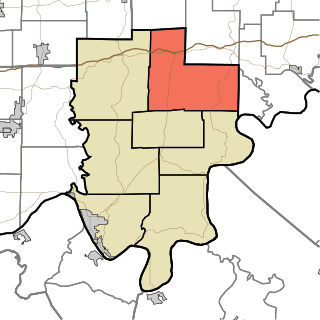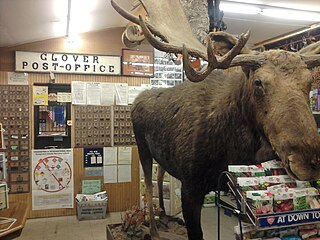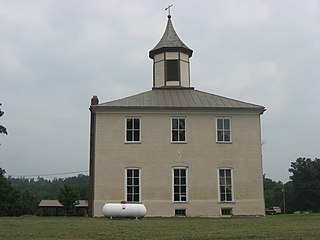
The Hoosier National Forest is a property managed by the United States Forest Service in the hills of southern Indiana. Composed of four separate sections, it has a total area of 202,814 acres. Hoosier National Forest's headquarters are located in Bedford, with a regional office in Tell City. Prominent places within the Forest include the Lick Creek Settlement, Potts Creek Rockshelter Archeological Site, and Jacob Rickenbaugh House.

The Corydon Historic District is a national historic district located in Corydon, Indiana, United States. The town of Corydon is also known as Indiana's First State Capital and as Historic Corydon. The district was added to the National Register of Historic Places in 1973, but the listing was amended in 1988 to expand the district's geographical boundaries and include additional sites. The district includes numerous historical structures, most notably the Old Capitol, the Old Treasury Building, Governor Hendricks' Headquarters, the Constitution Elm Memorial, the Posey House, the Kintner-McGrain House, and The Kintner House Inn, as well as other residential and commercial sites.

The Hoosier Theatre is a 225-seat historic theatre located at 209 Ferry Street in Vevay, Switzerland County, Indiana. It was built in 1837 as a warehouse and store to serve the town's large Ohio River traffic. Over the years it has housed a saddlery, the local post office, a tavern, the offices of the Vevay Newspaper, and a theatre, which it became in 1926. It was abandoned in 1955 and sat vacant until 1983, when Historic Vevay, Inc., a not-for-profit corporation was formed to purchase and restore the building. It re-opened in 1987 and continues to operate.

Oil Township is one of seven townships in Perry County, Indiana, United States. As of the 2010 census, its population was 2,546 and it contained 531 housing units.

Fulda is an unincorporated community in Harrison Township, Spencer County, in the U.S. state of Indiana. The Spencer County Memorial Forest features a World War II veterans memorial. There is a shooting match the first weekend of October.

Fiat is an unincorporated community in Penn Township, Jay County, Indiana.

The following is an alphabetical list of articles related to the U.S. state of Indiana.

A community post office (CPO) is a facility of the United States Postal Service located in and operated by a non-postal facility, such as a store. Also known by other terms, such as "contract postal unit", or "contract station", such a facility is a post office selling postal products and services at prices identical to those of a regular post office. In exchange for staffing the post office with its own employees, the owner of the facility is paid by the Postal Service in proportion to sales. A similar concept, the "village post office", was introduced in 2011; like the community post office, a village post office operates out of a private facility, but it offers fewer services than a community post office.

The Paul Dresser Birthplace is located in Fairbanks Park in Terre Haute, Vigo County, Indiana, at the corner of First and Farrington Streets. Listed on the National Register of Historic Places, it is the birthplace and boyhood home of Paul Dresser, a late-nineteenth-century singer, actor, and songwriter, who wrote and published more than 100 popular songs. On March 14, 1913, the Indiana General Assembly named Dresser's hit, "On the Banks of the Wabash, Far Away", the state song of Indiana.

The Tell City Oddfellows' Hall was a building in Tell City, Perry County, Indiana, United States; also known as the "Hall of Tell City Lodge, No. 206, IOOF", it was constructed in 1894. It served historically as an Independent Order of Odd Fellows meeting hall, as a multiple dwelling, as a specialty store, and as a business.

The Republic is an American daily newspaper published in Columbus, Indiana. It is owned by AIM Media Indiana, a subsidiary of AIM Media.

The Rockhouse Cliffs Rockshelters are a pair of rockshelters in the far southern region of the U.S. state of Indiana. Located amid broken terrain in the Hoosier National Forest, the shelters may have been inhabited for more than ten thousand years by peoples ranging from the Early Archaic period until the twentieth century. As a result of their extensive occupation and their remote location, they are important and well-preserved archaeological sites and have been named a historic site.

Thomas W. Swinney House, also known as The Swinney Homestead, is a historic home located at Fort Wayne, Indiana. It was built in 1844-1845 as a 1+1⁄2-story brick and limestone structure. It was enlarged with a 2+1⁄2-story, square, Late Victorian style brick wing about 1885. It features an Eastlake movement front porch. It was built by Thomas J. Swinney, a pioneer settler of Allen County and prominent Fort Wayne businessman. The house and land for Swinney Park were passed to the city of Fort Wayne in 1922.

Old Perry County Courthouse, also known as Rome Schoolhouse, is a historic courthouse located in Tobin Township, Perry County, Indiana. The building is located near the center of the community of Rome, Indiana. It was built in 1818, and is a two-story, square brick building with a hipped roof topped by a central cupola. The building served as the seat of county government until 1859. It then housed a school until 1966.

Cannelton Historic District is a national historic district located at Cannelton, Perry County, Indiana. The district encompasses 178 contributing buildings, 42 contributing structures, and 2 contributing objects in the central business district and surrounding residential and industrial areas of Cannelton. The area developed between 1837 and 1936, and includes notable examples of Gothic Revival, Late Victorian, and Bungalow / American Craftsman style architecture. A number of the buildings are constructed of native sandstone. Notable buildings include the National Historic Landmark Indiana Cotton Mill (1849-1850), St. Michael's Church (1859), F. H. Clemens Store, Cannelton Sewer Pipe Company, Josie Nicolay House, Myers Grade School / The Free School (1868), Jacob Heck Building (1882), Perry County Courthouse (1896-1897), and the separately listed St. Luke's Episcopal Church.

Irene Byron Tuberculosis Sanatorium-Physician Residences, also known as the Kidder and Draper-Sherwood Houses, were two historic homes located in Perry Township, Allen County, Indiana. They were designed by architect Charles R. Weatherhogg and built in 1934-1935 as housing for the medical director and head staff physician. Weatherhogg had earlier designed the sanatarium complex. The Kidder house was a two-story, Tudor Revival style frame dwelling with brick and stone cladding. The Draper-Sherwood House was a two-story, Colonial Revival style frame dwelling with one-story side wings. Surrounding the houses was a contributing formal landscape design.
Celina is an unincorporated community in Oil Township, Perry County, in the U.S. state of Indiana.

Andrew F. Scott House is a historic home located at Richmond, Wayne County, Indiana. It was built in 1858, and is a two-story, cubic, Italianate style brick dwelling. It has a hipped roof topped by a cupola and kitchen wing. It features a projecting pedimented central entrance bay flanked by one-story verandahs with decorated posts. From 1977 to 2004, it was owned by the Wayne County Historical Museum and operated as a historic house museum.

The T. C. Steele State Historic Site is located in rural Brown County, Indiana, one and a half miles south of Belmont, between Bloomington and Nashville, Indiana. The property was the studio and home of Hoosier Group landscape and portrait artist Theodore Clement Steele (1847–1926) and Selma Neubacher Steele (1870–1945), the artist's second wife. Shortly before her death in 1945, Selma donated the property on 211 acres of land to the Indiana Department of Conservation to establish a state historic site in memory of her husband. The property was listed on the National Register of Historic Places in 1973 as the Theodore Clement Steele House and Studio. The Indiana State Museum operates the historic site, which is open to the public and offers guided tours of the home and studio.

Centerville Historic District is a national historic district located at Centerville, Wayne County, Indiana. The district encompasses 115 contributing buildings in the central business district and surrounding residential sections of Centerville. It developed between about 1817 and 1873 and includes representative examples of Greek Revival, Italianate, and Federal style architecture. During this period it was county seat of Wayne County. Located in the district is the separately listed Oliver P. Morton House. Other notable contributing buildings include Morton's Row, Lantz' Row, Archway row, Tarkington Homestead, Jacob Julian House (1857), the Mansion House (1837), the Jones House, and the American House (1838–39).























